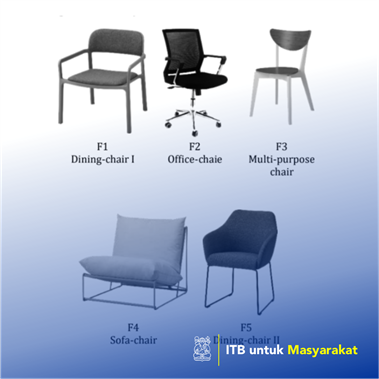

Achmad Syarief
The use of chairs as object of research was based on our understandings that it is a consumer product that are mostly approached and physically accessed before purchased. This direct physical interaction relates to consumers’ expectation and preconceived satisfaction (Shanat, M-Saili, J., 2018). 15 (fifteen) Sofa is the only object that is assigned to have soft, unique and comfortable attributes. Given the operational function of sofa is to accommodate leisure and comfort posture of users, the assigned semantic attributes perfectly suit the purpose. In addition, multi-purpose chair is the only object that is assigned to have compact attributes, which is perfectly suit its operational function as it is frequently moved and used in various places. Having exposed to the connectedness of operational purpose and semantic attributes, the author concludes that the shifting of how consumers interact with object from physical into digital, do not necessarily hinder and differ their judgment toward object. Thus, digitally presenting and displaying commercial products are no different than presenting on physical shop display. Whether this ‘similar’ result from different means of interaction (physical and digital interaction) relates to the actual purchasing of product is still subject of further study. Nevertheless, the study offers valuable insights to the discussions of human perceptual mechanism when interact with digitally presented objects. By understanding the interconnectedness of consumers’ actual perception and semantic judgments, the study not only place the importance of exposing how we (as consumers and users) react and adopt on object’s visuals but also for identifying the intangible connection between product features, the overall impression of product, and consumer behavior.
Penerapan Karya Tulis
Previous research in consumers’ behavior, asserted that a highly familiar product may easily perceived and therefore has higher probability of being chosen and purchased (Laio, Corsi, Lockshin, and Chryshochou, 2012). Yet, in contrary to popular beliefs, consumers’ perception and decision to purchase are ‘somewhat’ conducted in subconscious manner, rapidly done, and most likely emotional (Blakeslee, 2004’ Bradley-Lang, 1994). This indicates that products will still be looked for, chosen, and ultimately be purchased although consumers do not directly interact with them, as long as the product able to impress, persuade, and be familiar to consumers. It is interesting to understand how consumers perceive and interact with products when no physical interaction is permitted, especially in the time of social distance restriction due to covid-19 pandemic. All interactions are shifted into digital means, using websites, social media, and blogs to channel consumers’ interests. Thus, the necessity to consider visual presentation of product is increased as products are mostly presented on monitor display rather than physical display. The question is how consumers actually perceive the presented products on monitor display? To address this issue, the study explore consumers’ perception on the presented product visuals using self-reported questionnaire based on semantic differential method. This research is exploratory in nature, exploiting key semantic attributes of products as perceived by different gender and age-group of consumers.